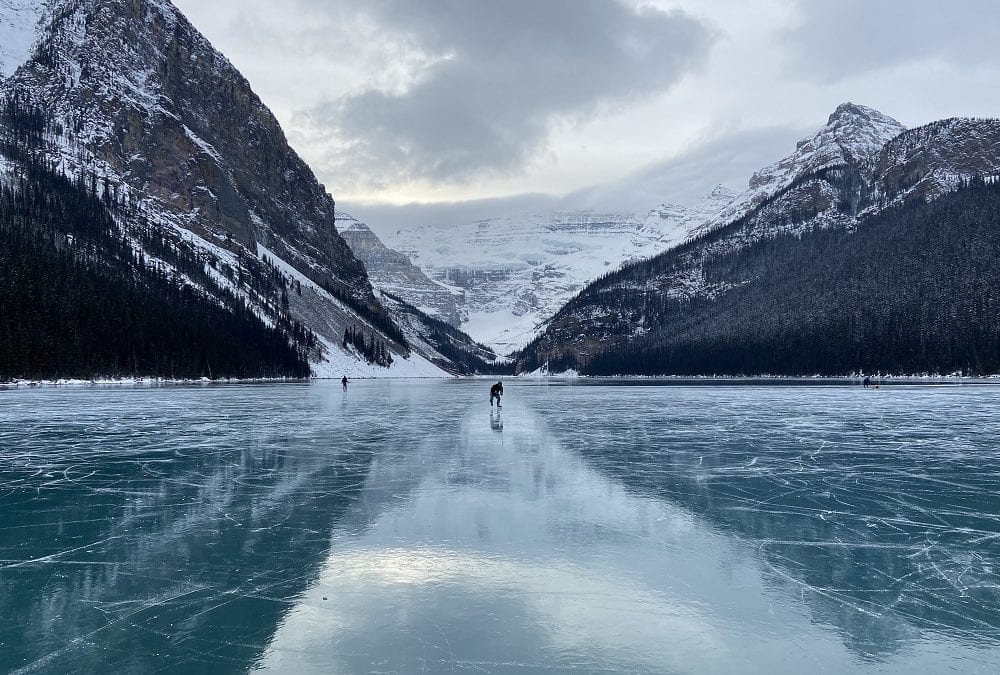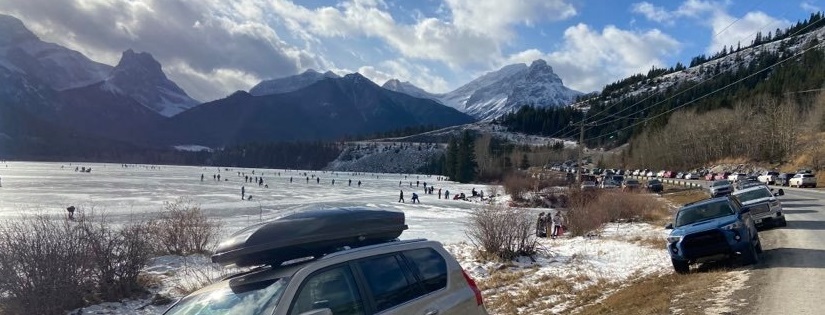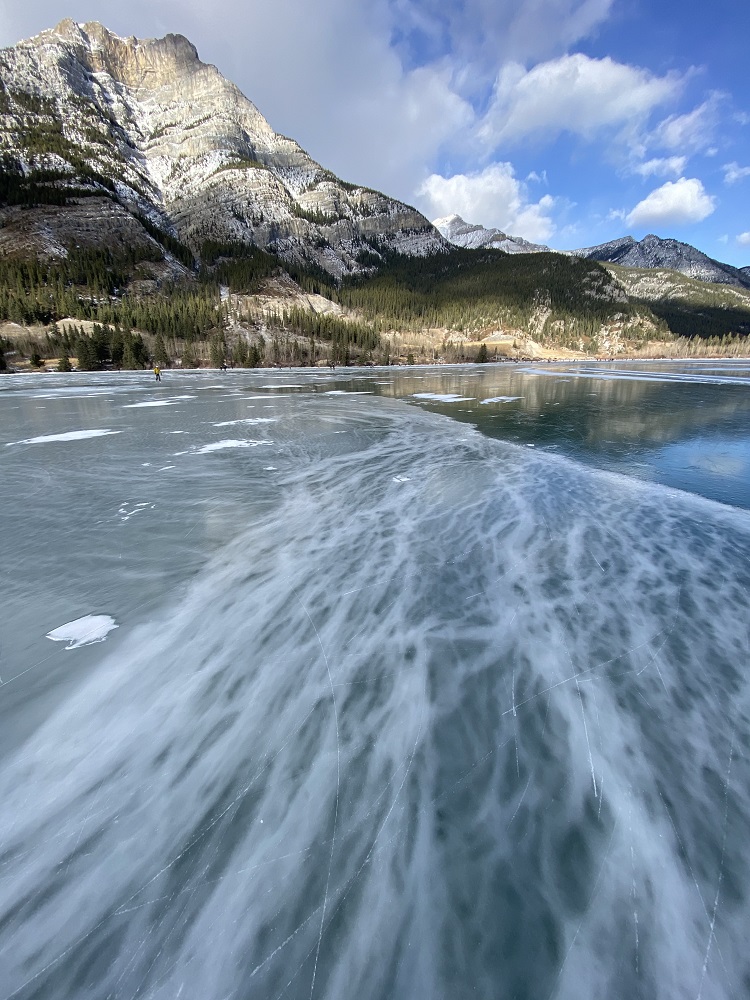The Boom of Mountain Lake Ice Skating
A Facebook group, the NHL and a mad rush to skate on Canada's wild ice

Over 4,000 years ago, people in Finland strapped flattened bones to their feet to skate on rivers and lakes. The popularity of skating spread to Scottish lakes and canals of the Netherlands. In the 13th and 14th centuries wood was substituted for bone, and in 1572 the first iron skates were made.
Fast forward through a few centuries of racing, figure skating and hockey, and we get to the boom of mountain lake skating in the Rocky Mountains of Canada.
There’s a Facebook page called Bow Valley Wild Ice that has over 4,500 followers, and when someone posts a conditions update about a lake, anything from a few people to over 100 people rush out.

People who’ve never skated on wild ice might wonder when it’s safe. The simplest way is to measure the thickness using a number of techniques. See below for backcountry skating tips.
The Bow Valley stretches from Bow Glacier on the Icefields Parkway to Lake Louise and east through Banff and towards Calgary along the Bow River. There are a number of lakes and rivers, such as Bow Lake, Lake Louise, Johnson Lake, Vermilion Lakes, Lake Minnewanka, Carrot Creek, Canmore Reservoir, Gap Lake, Grotto Pond and more.
I’ve been skating since I was five years old, and have had the pleasure of skating on the Ottawa River, at Nathan Phillips Square in Toronto, at the Whistler Olympic Plaza, on the Bonsecours Basin in Montreal and on Great Slave Lake in northern Canada, but I’ve never seen this much interest in lake skating.
I spoke to a family that drove from Edmonton after seeing a Facebook post about Lake Louise being frozen. They said they’d always wanted to skate on clear ice and that the 4.5-hour drive was worth it.
I touched base with an old friend on Johnson Lake, who drove 1.5 hours from Golden, B.C. And I played hockey with a group who drove six hours from Nelson, B.C. Other skaters were from Calgary, Cochrane, Airdrie, Okotoks, Canmore and Banff.
Bow Valley photographer Paul Zizka took a photo of Lee Nordby skating on Lake Louise, which the NHL shared on their social media. Check it out:
Over 100 cars were parked at Gap Lake, between Canmore and Exshaw along Highway 1A, this weekend. Music was playing, people wore costumes, dogs ran around, families skated together, hockey games took place and a large Canadian flag was flown.
The flag was being passed between skaters, which reminded me of that famous quote by Canadian Olympic gold medalist, Hayley Wickenheiser: “Wave it high, and don’t trip and fall.”
A few people tripped and fell, but spirits were so high that it was only the cold winds gusting across the lake from West Wind Pass that sometimes silenced folks.

It was so busy that Police showed up for traffic control, and to remind people to park far off the road and into the ditch. If you’re going skating in the mountain Parks, be sure to have a Parks pass and park in designated areas.
The Bow Valley’s lakes are frozen and are good to skate on. You have to watch for cracks, bumpy ice, changes in solidity, rocks and other hazards, but you won’t regret experiencing these lakes before they’re covered in snow.
Enjoy this short video of a cute little dog with a tennis ball wearing a sweater and pants.
Backcountry Skating Tips
Visually inspect the area: Upon arriving, take a look around to see if others have been there. Look for cracks, pressure ridges, dark areas (thinner ice) and slushy areas. Look for open water and objective hazards like rocks. Look for frozen bubbles, they can sometimes help you gauge thickness.
Measure the ice: The Canadian Red Cross suggests: 15 cm (~5 inches) for walking or skating alone, 20 cm for hockey and 25 cm for snowmobiles. Typically, backcountry skaters will avoid anything less than 7 cm (~3 inches). Ice conditions vary from lake to lake.
Measuring in one place is not enough, be sure to take measurements in several different areas to ensure that the entire area is safe. Read more about measuring ice before heading out.

Ice colour: The colour of ice may be an indication of its strength. Clear blue ice is strongest. White opaque or snow ice is half as strong as blue ice. Opaque ice is formed by wet snow freezing on the ice. Grey ice is unsafe. The grayness indicates the presence of water.
Bring a shovel: It’s rare to find backcountry ice that doesn’t have fresh snow or snow drifts. Skate with a shovel to clear and inspect the area as you go.
Bring a headlamp: It can get dark quick and if you’re far from shore or your car, you’ll want to be able to find your way back without relying on the stars.
Wear a helmet: Skiers, climbers, paddlers and bikers wear them, so skaters should too. Get in the habit of wearing a helmet on backcountry lakes. You never know when you’ll catch an edge in a crack or hit a rock and take a tumble.
Wear a life jacket (PFD): If you’re exploring a remote lake or are unsure of the ice quality, then bring a life jacket. More than one skater has gone into the water and lived because they wore one.
Know rescue techniques: Rescuing another person from ice can be dangerous. The safest way to perform a rescue is from shore. Call for help. Consider whether you can quickly get help from trained professionals (police, fire fighters or ambulance) or bystanders.
Check if you can reach the person using a long pole or branch from shore – if so, lie down and extend the pole to the person. If you go onto ice, wear a PFD and carry a long pole or branch to test the ice in front of you.
Bring something to reach or throw to the person (e.g. pole, weighted rope, line or tree branch). When near the break, lie down to distribute your weight and slowly crawl toward the hole. Remaining low, extend or throw your emergency rescue device (pole, rope, line or branch) to the person. Have the person kick while you pull them out.

Self-rescue: If you get into trouble on ice and you’re by yourself: Call for help. Resist the immediate urge to climb back out where you fell in. The ice is weak in this area. Try to relax and catch your breath. Turn yourself toward shore so you are looking at where you entered onto the ice.
The ice is more stable close to shore. Reach forward onto the broken ice without pushing down. Kick your legs to try to get your body into a horizonal position. Continue kicking your legs, and crawl onto the ice. When you are back on the ice, crawl on your stomach or roll away from the open area with your arms and legs spread out as far as possible to evenly distribute your body weight.
Do not stand up! Look for shore and make sure you are crawling in the right direction.
Bring a stove: Bring a backcountry stove to boil water for a hot beverage beore and after your skate. If you’re planning to stay out all day, there’s nothing better than a hot lunch. For a review of the best 2020 stoves visit here.
Warm clothes in car: It can get cold on the lake, so having dry and warm clothes waiting for you in the car can make the drive home a lot nicer. Maybe throw a warm sleeping bag in there to wrap yourself in. For nine three-season sleeping bags visit here.


